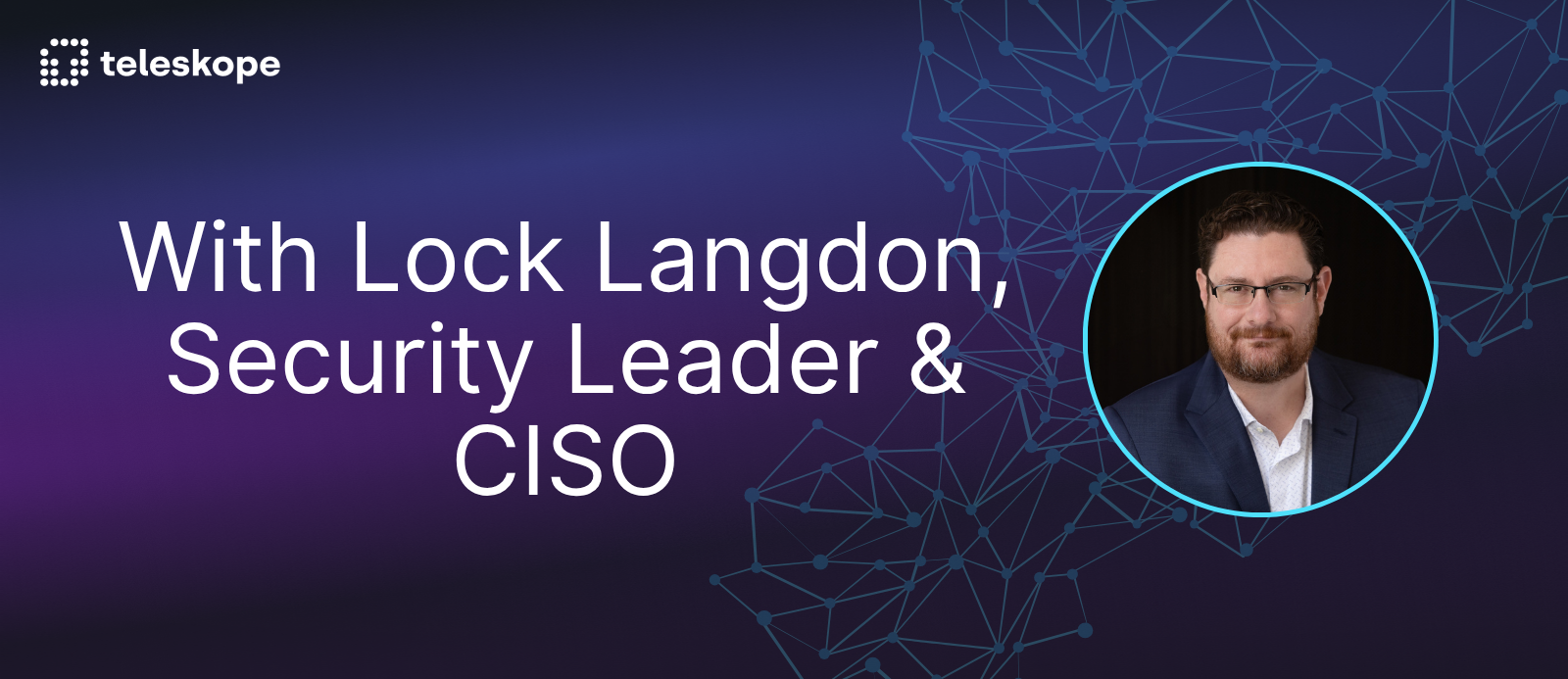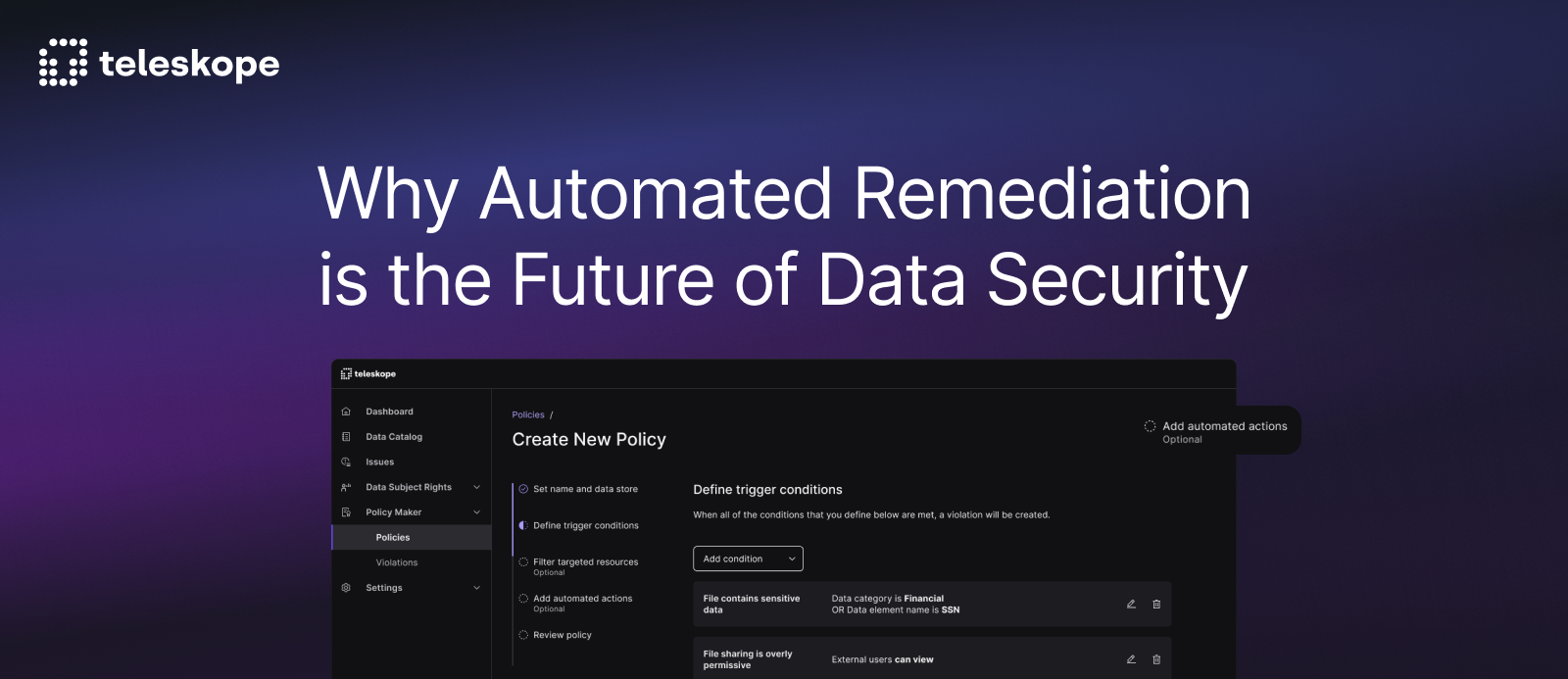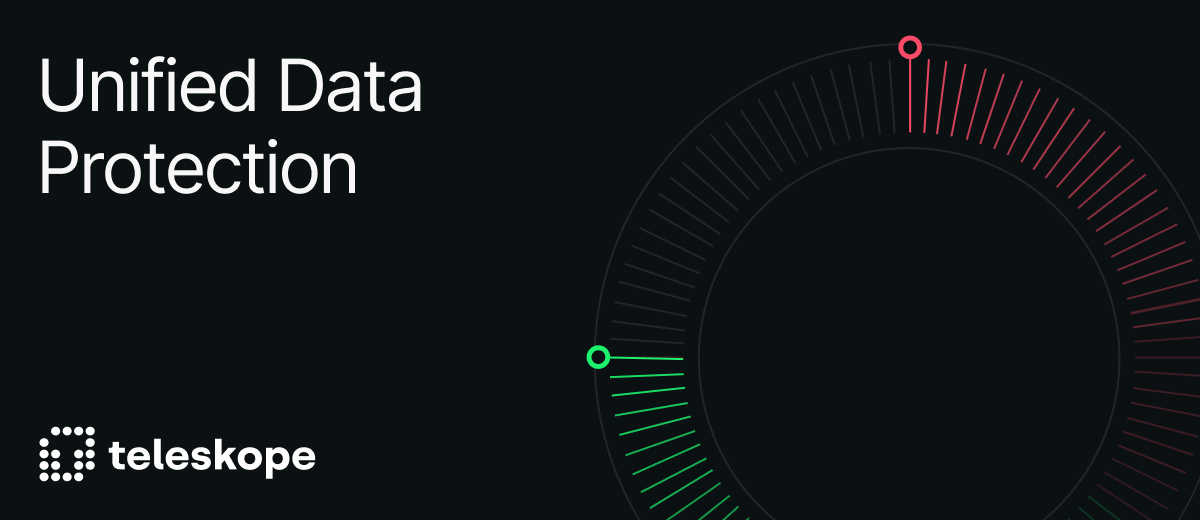Building an End-to-End Data Protection Strategy
Insights

Amid evolving threat landscapes, enterprise data sprawl, and a rising frequency of breaches, organizations are quickly shifting their view of data security from an IT afterthought to a strategic imperative.
However, executing on this imperative is easier said than done. With the abundance of modern DSPM and DLP tools, each promising to bring additional clarity to your data footprint, constructing the right stack, policies, and internal workflows can be a daunting process, especially for organizations with a team count in the thousands.
That’s why we sat down with Aprio’s Vice President and CISO Lock Langdon to get his insider knowledge on how organizations can establish a robust data security posture. Touching on his 25+ years of experience in IT and cybersecurity, Lock shares his insights on the current state of data security, how organizations can better understand risk, and the key components of an end-to-end data protection strategy.
Q: Data Security Seems to Have Strong Tailwinds Now. What Changes Have You Seen and How Has AI Impacted the Space?
Langdon: Organizations have long understood that data is the lifeblood of their operations, reputation, and revenue. If data isn’t protected, clients lose trust, established reputations can be irreversibly damaged, and the bottom-line impact of even a single breach can be substantial. With that realization comes the urgency to secure sensitive information across one’s data footprint.
Of course, data security was never an easy thing to implement. Most initiatives required substantial upfront investments with potentially no return, which made organizations hesitant to pull the trigger. Most legacy data security tools also focused on file movements and access controls, which left ambiguity about what information was actually at risk. Even when DLP tools came along, they also required extensive manual work just to manage false positives, and most organizations simply didn’t have the resources.
LLMs and generative AI have upended data security. Instead of relying on legacy pattern-matching alone, we can now understand the context of the data being scanned alongside even more accurate field detection. Modern data discovery tools can classify documents in seconds, place them in the right locations, and use that visibility to trigger actions and responses that actually reduce risk.
Q: How Can Organizations Better Understand Data Risk and Measure the Impact of Solutions Implemented?
Langdon: Generally, I think organizations, or at least business entities, understand the risks of unprotected data today. In the past, the blocker was always the implementation process. Even when leadership recognized the risks, they often didn’t have the ability or technical control to actually do anything about it. Modern data security tools like Teleskope have lowered the barriers to implementation significantly.
For organizations trying to quantify the impact of investing in data security solutions, it’s best to start by taking a holistic look at all the sensitive information you control. There are dozens of amazing reports like the Verizon DBIR and IBM CODB, that quantify the value of specific file types and the cost of breaches, and you can extrapolate those numbers to determine your own exposure. Going even further are tools like the FAIR model that help quantify risk in business terms.
However every solution mentioned needs to start with understanding. You can only measure what you understand. When you size the problem, you can quantify the risk and attach a dollar value. Showing that today’s investments keep that number off tomorrow’s bottom line is the impact leadership expects.
Q: For Organizations Evaluating Data Security Tools, What Should They Consider When Building Their Stack?
Langdon: We’ve seen a big shift toward platformization rather than consolidating multiple best-in-breed tools. The latter path used to be the way to do it because you could build all these nuanced overlapping detections that give you robust defense and depth. But then you realize that alert fatigue and tool sprawl quickly undermine those benefits, especially for organizations with lean security teams.
It’s generally best practice to look for tools that close the gap between discovery and remediation. We see how efficient DSPMs are at surfacing risks, but then they push teams back to legacy tools or manual processes for remediation. Comprehensive tools like Teleskope help close that gap. They have the same AI-powered discovery and classification capabilities as DSPMs, but give you a way to actually do something about the problem, versus saying, “Hey, here’s your problem. Go figure out how to solve it.”
Q: What Are the Key Components of an End-to-End Data Protection Strategy?
Langdon: Discovery and classification tell you what you have; remediation and prevention let you enforce policy in practice; monitoring keeps it from becoming a one-time exercise. Treating them as separate tools is where teams get stuck.
- Discovery: Use modern discovery tools to surface what’s actually in files and find shadow data, developer-created database clones, copies outside client folders, and catch M&A migration anomalies.
- Classification: Here’s where you want to lean on AI to contextualize documents (like recognizing a 1099 with SSNs, bank accounts, addresses) rather than regex, which was historically brittle and produced false positives. As AI workflows become more reliable, you’ll trust labels more and move to action quicker.
- Automated Remediation: Encode policy so remediation actions execute automatically. While many organizations rely on manual remediation flows, the sheer amount of alert fatigue, ticket chasing, and context switching makes them unfeasible at scale. If automations aren’t your forte, lean on end-to-end data security solutions like Teleskope.
- Prevention: Write policy automations so risky data doesn’t spread, keep client data in approved folders, stop non-compliant copies, and use client record number/name matches to prevent duplicates from proliferating. Once this foundation is established, it’s “set it once and forget it.”
- Monitoring: Treat this as continuous post-implementation work. Watch movement over time (file here, now file here), confirm data locality and retention, and use tags to audit M&A cleanups and catch regressions (including new developer clones).
Q: How Does Automation Enhance Data Security?
Langdon: Automations are the only way to enforce data protection at scale while also preserving internal bandwidth. Having built automation programs at several enterprises, I found that when you place menial tasks on autopilot, you can allocate your time toward more tactical initiatives.
The best automations come from the people closest to the activity. Modern discovery gives us the details to write policy as code, and contextual classification means we can trust those labels enough to act. Instead of stopping at “here’s your problem,” we encode the rule and let it run. Once those onboard policy rules are set, it’s set it once and forget it; we’re not staffing an army to chase alerts.
Q: What Best Practices Would You Recommend to Automate Each Component, Using a Tool Like Teleskope?
Langdon: All data protection strategies start at discovery. Teleskope automatically detects and classifies sensitive information across major cloud providers, SaaS platforms, and on-prem systems without requiring data movement. This ensures you have the always-on visibility needed to mitigate enterprise data sprawl.
Next is remediation, the step where most point solutions fall short. Through Teleskope, you can automate remediation workflows like data deletion, redaction, and access revocation to ensure consistent enforcement of policies across environments. This step minimizes risk and closes security gaps without requiring security teams to allocate hours toward manual tasks.
Establishing this foundation with Teleskope makes prevention and monitoring second nature. With every step from discovery to remediation being handled in the background, teams can allocate their time toward auditing findings and monitoring their posture against evolving compliance standards like NIST, SOC2, and PCI-DSS.
Solidify Your Data Security Strategy With Teleskope
The more distributed your data becomes, the more unified your visibility and control need to be. Point solutions create pockets of insight without authority, and that gap is where risk multiplies.
Teleskope brings the pieces together into one end-to-end platform. You get continuous discovery with contextual understanding of what’s inside files; classification you can trust; and automated policy enforcement at scale. The result is a closed loop: find sensitive data, fix it automatically, and keep it where it belongs with real-time prevention and ongoing monitoring.
Get started with Teleskope today.
Introduction
Kyte unlocks the freedom to go places by delivering cars for any trip longer than a rideshare. As part of its goal to re-invent the car rental experience Kyte collects sensitive customer data, including driver’s licenses, delivery and return locations, and payments information. As Kyte continues to expand its customer base and implement new technologies to streamline operations, the challenge of ensuring data security becomes more intricate. Data is distributed across both internal cloud hosting as well as third party systems, making compliance with privacy regulations and data security paramount. Kyte initially attempted to address data labeling and customer data deletion manually, but this quickly became an untenable solution that could not scale with their business. Building such solutions in-house didn’t make sense either, as they would require constant updates to accommodate growing data volumes which would distract their engineers from their primary focus of transforming the rental car experience.
- list
- list
- list
- list
Continuous Data Discovery and Classification
In order to protect sensitive information, you first need to understand it, so one of Kyte’s primary objectives was to continuously discover and classify their data at scale. To meet this need, Teleskope deployed a single-tenant environment for Kyte, and integrated their third-party saas providers and multiple AWS accounts. Teleskope discovered and crawled Kyte’s entire data footprint, encompassing hundreds of terabytes in their AWS accounts, across a variety of data stores. Teleskope instantly classified Kyte’s entire data footprint, identifying over 100 distinct data entity types across hundreds of thousands of columns and objects. Beyond classifying data entity types, Teleskope also surfaced the data subjects associated with the entities, enabling Kyte to categorize customer, employee, surfer, and business metadata separately. This automated approach ensures that Kyte maintains an up-to-date data map detailing the personal and sensitive data throughout their environment, enabling them to maintain a structured and secure environment.
Securing Data Storage and Infrastructure
Another critical aspect of Kyte’s Teleskope deployment was ensuring the secure storage of data and maintaining proper infrastructure configuration, especially as engineers spun up new instances or made modifications to the underlying infrastructure. While crawling Kyte’s cloud environment, Teleskope conducted continuous analysis of their infrastructure configurations to ensure their data was secure and aligned with various privacy regulations and security frameworks, including CCPA and SOC2. Teleskope helped Kyte identify and fortify unencrypted data stores, correct overly permissive access, and clean up stale data stores that hadn’t been touched in a while. With Teleskope deployed, Kyte’s team will be alerted in real time if one of these issues surfaces again.
End-to-End Automation of Data Subject Rights Requests
Kyte was also focused on streamlining data subject rights (DSR) requests. Whereas their team previously performed this task manually and with workflows and forms, Kyte now uses Teleskope to automate data deletion and access requests across various data sources, including internal data stores like RDS, and their numerous third-party vendors such as Stripe, Rockerbox, Braze, and more. When a new DSR request is received, Teleskope seamlessly maps and identifies the user’s data across internal tables containing personal information, and triggers the necessary access or deletion query for that specific data store. Teleskope also ensures compliance by automatically enforcing the request with third-party vendors, either via API integration or email, in cases where third parties don’t expose an API endpoint.
Conclusion
With Teleskope, Kyte has been able to effectively mitigate risks and ensure compliance with evolving regulations as their data footprint expands. Teleskope reduced operational overhead related to security and compliance by 80%, by automating the manual processes and replacing outdated and ad-hoc scripts. Teleskope allows Kyte’s engineering team to focus on unlocking the freedom to go places through a tech-enabled car rental experience, and helps to build systems and software with a privacy-first mindset. These tangible outcomes allow Kyte to streamline their operations, enhance data security, and focus on building a great, secure product for their customers.


from our blog

